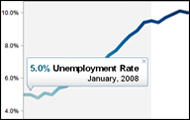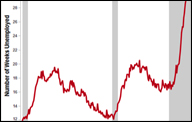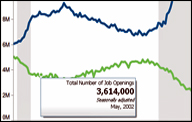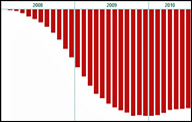
The recession may have officially ended in June of 2009, but unemployment peaked several months later and has remained above 9 percent for over a year, according to Labor Department data and a recent report by the National Bureau of Economic Research.
In recent recessions, employment hit rock bottom several months after official end dates, according to the report. The most recent recession, which began in December 2007, officially lasted 18 months making it the longest since World War II, the report said.
The NBER's Business Cycle Dating Committee used several indicators of economic activity to determine the recession's end date and found that employment reached a trough, or low point, six months after the recession's official end.
The unemployment rate, which is a measure of the size of the labor force, may have peaked at 10.1 percent in October 2009, but the number of people actually employed bottomed out at 137.8 million in December 2009, according to seasonally adjusted data from the Bureau of Labor Statistics. For more on how the rate is calculated, see our interactive unemployment tutorial.
Although the nation is officially in a period of recovery, the committee included this cautionary note: "In determining that a trough occurred in June 2009, the committee did not conclude that economic conditions since that month have been favorable or that the economy has returned to operating at normal capacity. Rather, the committee determined only that the recession ended and a recovery began in that month.
"The trough marks the end of the declining phase and the start of the rising phase of the business cycle. Economic activity is typically below normal in the early stages of an expansion, and it sometimes remains so well into the expansion."
Read the full report from NBER's Business Cycle Dating Committee
Use an interactive graph to look back at the unemployment rate and job growth since the start of the recession.
Visit the State of the USA's economy section to learn more about unemployment and job growth. Read about recent economic trends below.
Long-Term Unemployment
The duration of unemployment has pulled back from record highs seen in July. Bureau of Labor Statistics data show that the average, or mean, number of weeks fell from 35.2 weeks in June to 34.2 in July and 33.6 in August. The median number of weeks unemployed fell from 25.5 weeks in June to 22.2 in July and 19.9 in August.
Job Openings and Unemployment
Meanwhile, according to the BLS, the number of job openings is on the rise. Data released earlier this summer revealed a wide gap between the jobless and the number of available jobs. Now, revised data find job openings climbing from a total of 2.86 million in June to a preliminary estimate of 3.04 million for July. However, the total number unemployed increased from 14.55 million in July to a preliminary estimate of 14.86 million in August.
Job Growth
Revised numbers for June show more than 7.87 million private-sector jobs lost since December 2007. That number shrank to 7.77 million in July and 7.70 million in August, according to the BLS revisions. For a look at the previous numbers, see Still In the Red: The Recession's Impact on Job Growth.
What Do You Think?
Have you read the second part of this series - A Portrait of the Recession: Gross Domestic Product?
Share your thoughts in the comments section below or weigh in on Facebook or Twitter.Data visualization by Anthony Calabrese, a State of the USA Web producer.


